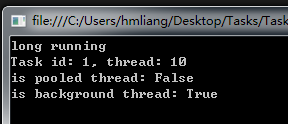任务表示应完成的某个单元的工作。这个单元的工作可以在单独的线程中运行,也可以以同步方式启动一个任务,这需要等待主调用线程。使用任务不仅可以获得一个抽象层,还可以对底层线程进行很多控制。
1.启动任务
要启动任务,可以使用TaskFactory类或Task类的构造函数和Start()方法。Task类的构造函数在创建任务上提供的灵活性较大。
1).任务方法

static object taskMethodLock = new object(); static void TaskMethod(object title) { lock (taskMethodLock) { Console.WriteLine(title); Console.WriteLine("Task id: {0}, thread: {1}", Task.CurrentId == null ? "no task" : Task.CurrentId.ToString(), Thread.CurrentThread.ManagedThreadId); Console.WriteLine("is pooled thread: {0}", Thread.CurrentThread.IsThreadPoolThread); Console.WriteLine("is background thread: {0}", Thread.CurrentThread.IsBackground); Console.WriteLine(); } }
2).使用线程池的任务

static void TasksUsingThreadPool() { var tf = new TaskFactory(); Task t1 = tf.StartNew(TaskMethod, "using a task factory"); Task t2 = Task.Factory.StartNew(TaskMethod, "factory via a task"); var t3 = new Task(TaskMethod, "using a task constructor and Start"); t3.Start(); Task t4 = Task.Run(() => TaskMethod("using the Run method")); }
执行结果:

3).同步任务
任务也可以同步运行,已相同的线程作为主调用线程。
注:主线程是一个调用前台线程,没有任务ID,也不是线程池中的线程。

private static void RunSynchronousTask() { TaskMethod("just the main thread"); var t1 = new Task(TaskMethod, "run sync"); t1.RunSynchronously(); }
执行结果:

4).使用单独线程的任务
如果任务的代码应该长时间运行,就应该使用TaskCreationOptions.LogRunning告诉任务调度器创建一个新线程,而不是使用线程池中的线程。

private static void LongRunningTask() { var t1 = new Task(TaskMethod, "long running", TaskCreationOptions.LongRunning); t1.Start(); }
执行结果:

2.Future——任务结果
任务结束时,它可以把一些有用的状态信息写到共享对象中。这个对象必须是线程安全的。另一个选项是使用返回某个结果的任务。这种任务也叫Future,因为它返回一个结果。

static Tuple<int, int> TaskWithResult(object division) { Tuple<int, int> div = (Tuple<int, int>)division; int result = div.Item1 / div.Item2; int reminder = div.Item1 % div.Item2; Console.WriteLine("task creates a result..."); return Tuple.Create<int, int>(result, reminder); }

static void ResultsFromTasks() { var t1 = new Task<Tuple<int, int>>(TaskWithResult, Tuple.Create<int, int>(8, 3)); t1.Start(); Console.WriteLine(t1.Result); t1.Wait(); Console.WriteLine("result from task: {0} {1}", t1.Result.Item1, t1.Result.Item2); }
执行结果:

3.连续任务
通过任务,可以指定在任务完成后,应开始运行另一个特定任务。
注:无论前一个任务是如何结束的,前面的连续任务总是在前一个任务结束时启动。使用TaskContinuationOptions枚举中的值,可以指定,连续任务只有在起始任务成功(或失败)结束时启动。一些可能的值是OnlyOnFaulted、NotOnFaulted、OnlyOnCanceled和OnlyOnRanToCompletion。

static void DoOnFirst() { Console.WriteLine("doing some task {0}", Task.CurrentId); Thread.Sleep(3000); } static void DoOnSecond(Task t) { Console.WriteLine("task {0} finished", t.Id); Console.WriteLine("this task id {0}", Task.CurrentId); Console.WriteLine("do some cleanup"); Thread.Sleep(3000); } static void DoOnError(Task t) { Console.WriteLine("task {0} had an error!", t.Id); Console.WriteLine("my id {0}", Task.CurrentId); Console.WriteLine("do some cleanup"); }

static void ContinuationTask() { Task t1 = new Task(DoOnFirst); Task t2 = t1.ContinueWith(DoOnSecond); Task t3 = t1.ContinueWith(DoOnSecond); Task t4 = t2.ContinueWith(DoOnSecond); Task t5 = t1.ContinueWith(DoOnError, TaskContinuationOptions.OnlyOnFaulted); t1.Start(); Thread.Sleep(5000); }
执行结果:

4.任务层次结构
利用任务连续性,可以在一个任务结束后启动另一个任务。任务也可以构成一个层次结构。一个任务启动一个新任务时,就启动了一个父/子层次结构。
如果父任务在子任务之前结束,父任务的状态就显示为:WaitingForChildrenToComplete。所有的子任务也结束时,父任务的状态就变成RanToCompletion。

static void ParentAndChild() { var parent = new Task(ParentTask); parent.Start(); Thread.Sleep(2000); Console.WriteLine(parent.Status); Thread.Sleep(4000); Console.WriteLine(parent.Status); } static void ParentTask() { Console.WriteLine("task id {0}", Task.CurrentId); var child = new Task(ChildTask); // , TaskCreationOptions.DetachedFromParent); child.Start(); Thread.Sleep(1000); Console.WriteLine("parent started child"); // Thread.Sleep(3000); } static void ChildTask() { // Console.WriteLine("task id {0}, parent: {1}", Task.Current.Id, Task.Current.Parent.Id); Console.WriteLine("child"); Thread.Sleep(5000); Console.WriteLine("child finished"); }
执行结果:

